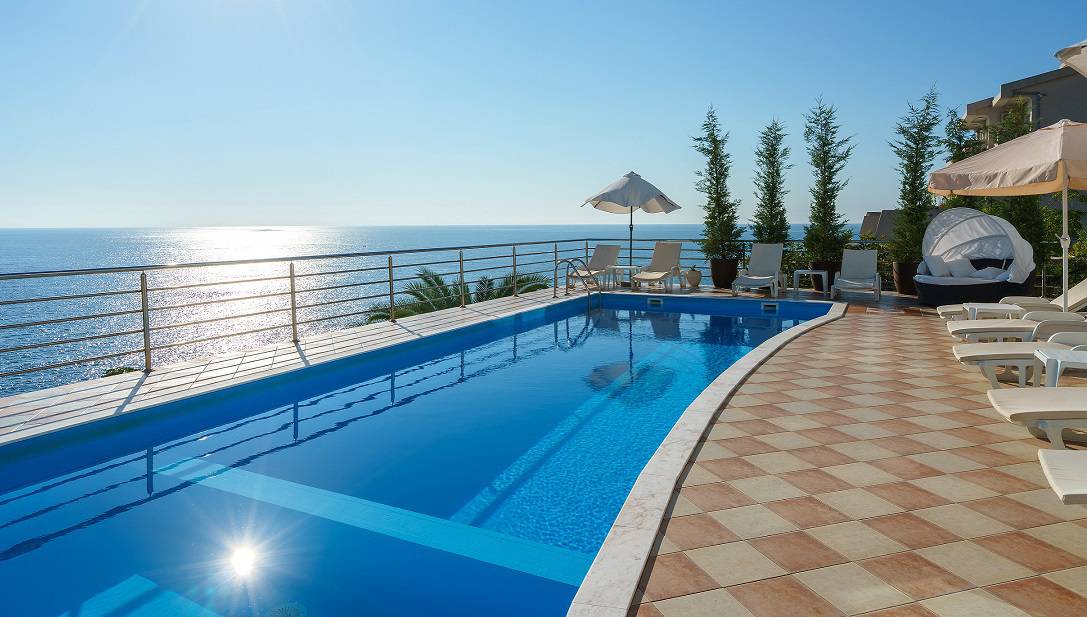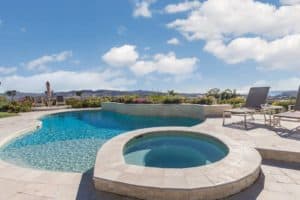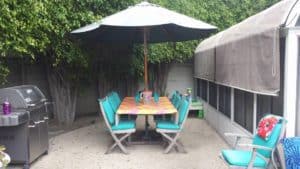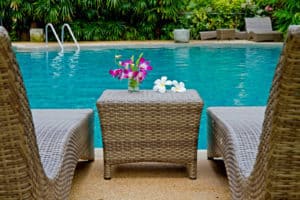In the winter, we will often hear “Our pool guy has not been here for weeks”. After thorough investigation, our management finds out that this assumption is based on the chlorine tablet dispenser in the customer’s pool being empty. Many customers will assume that we have not serviced their pool, because there are no chlorine tablets in the chlorine tablet dispenser. Well, we try not to add chlorine tablets as soon as possible in the year weather permitting. Let’s start with some basics about pool water chemistry to help explain why we prefer liquid chlorine over tablet form chlorine when possible. Liquid chlorine does not have conditioner in it!
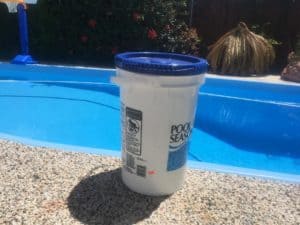 The first thing to understand is that chlorine tablets almost always have conditioner in them. The ideal level of conditioner in pool water is 50 ppm to 80 ppm. If we were to add chlorine tablets to the pool every week of every year, we would see nearly all of our swimming pools with 300 ppm to 500 ppm of conditioner over the course of 5 to 10 years. This leads to major alkalinity problems in the pool water. Conditioner (also known as stabilizer or cyanuric acid) is necessary in pool water, but not at those extreme levels. You can read about the importance of pool conditioner here, but too much of it is a bad thing.
The first thing to understand is that chlorine tablets almost always have conditioner in them. The ideal level of conditioner in pool water is 50 ppm to 80 ppm. If we were to add chlorine tablets to the pool every week of every year, we would see nearly all of our swimming pools with 300 ppm to 500 ppm of conditioner over the course of 5 to 10 years. This leads to major alkalinity problems in the pool water. Conditioner (also known as stabilizer or cyanuric acid) is necessary in pool water, but not at those extreme levels. You can read about the importance of pool conditioner here, but too much of it is a bad thing.
Carbonate Alkalinity Equals Total Alkalinity Minus Cyanuric Alkalinity
Conditioner is also an alkaline and the higher your cyanuric alkalinity is, the higher your total alkalinity is in the pool. This will get a little complicated, so I will try to simplify. There are 2 main sources of alkalinity in pool water chemistry. There is cyanuric alkalinity and carbonate alkalinity. The true goal in our pool water chemistry is 80 ppm to 120 ppm of carbonate alkalinity.
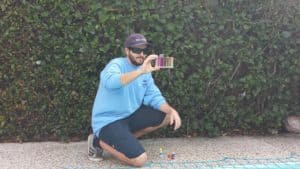 Most test kits test for total alkalinity which does not isolate carbonate alkalinity from cyanuric alkalinity. Many pool services and homeowners test for total alkalinity and are satisfied with an 80 ppm to 120 ppm result. The problem with this is that this does not mean the carbonate alkalinity is 80 ppm to 120 ppm. So, I’m sure your thinking to yourself “O.k., how do you isolate and measure what the carbonate alkalinity is?” Let’s explore this:
Most test kits test for total alkalinity which does not isolate carbonate alkalinity from cyanuric alkalinity. Many pool services and homeowners test for total alkalinity and are satisfied with an 80 ppm to 120 ppm result. The problem with this is that this does not mean the carbonate alkalinity is 80 ppm to 120 ppm. So, I’m sure your thinking to yourself “O.k., how do you isolate and measure what the carbonate alkalinity is?” Let’s explore this:
Our equation to find carbonate alkalinity is Total alkalinity – Cyanuric Alkalinity = Carbonate Alkalinity. We have to find out what the cyanuric alkalinity is. To find the cyanuric alkalinity, we have to measure the conditioner level and convert that into the cyanuric alkalinity level. To do this, we have to multiply the conditioner level by the cyanuric factor (depends on the pH) and then subtract that cyanuric alkalinity from the total alkalinity. You can read our article “Pool Conditioner Is Important” for more detailed information about measuring cyanuric alkalinity or we have found a way to simplify by just dividing our conditioner level by 3 to find our cyanuric alkalinty. This is a rough estimate (not exact or precise), but close enough and it has worked well for us.
Too Much Conditioner Can Lead To Aggressive Pool Water
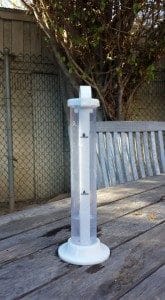 For example: Our pool has 200 ppm of conditioner and 120 ppm of total alkalinity. 200 ppm divided by 3 is roughly 66 ppm. 66 ppm is our cyanuric alkalinity which we subtract from 120 ppm to find our carbonate alkalinity. Remember total alkalinity – cyanuric alkalinity = carbonate alkalinity. So, 120 ppm total alkalinity – 66 ppm cyanuric alkalinity = 54 ppm carbonate alkalinity . Ideal carbonate alkalinity is 80 ppm to 120 ppm which means our carbonate alkalinity in this example is low and therefore this pool water is aggressive. If our conditioner in this pool water was 100 ppm, our carbonate alkalinity would be 87 and ideal.
For example: Our pool has 200 ppm of conditioner and 120 ppm of total alkalinity. 200 ppm divided by 3 is roughly 66 ppm. 66 ppm is our cyanuric alkalinity which we subtract from 120 ppm to find our carbonate alkalinity. Remember total alkalinity – cyanuric alkalinity = carbonate alkalinity. So, 120 ppm total alkalinity – 66 ppm cyanuric alkalinity = 54 ppm carbonate alkalinity . Ideal carbonate alkalinity is 80 ppm to 120 ppm which means our carbonate alkalinity in this example is low and therefore this pool water is aggressive. If our conditioner in this pool water was 100 ppm, our carbonate alkalinity would be 87 and ideal.
A good rule of thumb is to just know to try and keep the pool conditioner level between 50 ppm and 80 ppm which is why we try to add liquid chlorine instead of tablet chlorine weather permitting. The only permanent way to remove conditioner is to drain your pool water or use pool water recycling which is why adding liquid chlorine instead of tablet chlorine will extend the life of your swimming pool!
Another important item to know is most pool conditioner test kits only test up to 100 ppm. This means that a 100 ppm test result is at least 100 ppm. The only way to test for exact levels when conditioner is over 100 ppm is to dilute the pool water sample with fresh water. Read how we do this in our article “Pool Conditioner Is Important”.
Liquid Chlorine Does Not Add Conditioner To Pool Water
Like calcium, pool conditioner is constant in pool water, so it’s best to limit over tabbing the swimming pool and thus over-conditioning. In the event of high pool conditioner, it is best to switch to liquid chlorine until the pool conditioner level drops to ideal levels at 50 ppm to 80 ppm. There are some challenges with liquid chlorine which is why we say “weather permitting” when optimally using liquid chlorine.
Liquid chlorine is instant in the pool water, so when a weekly pool service adds the proper amount of liquid chlorine to the swimming pool, they have to add enough to last a full week. We have to add enough liquid chlorine to measure an ideal level over a 7 day period which means our chlorine level will start high and end ideal which can be extreme in the summer with warm weather and high use. This is the advantage of chlorine tabs as they are slow dissolving and constantly adding a small amount of chlorine to the pool water. This constant slow adding of chlorine results in less dramatic swings of chlorine concentration in the pool or spa water which is ideal with heavy use and warm weather.
Liquid Chlorine Promotes Perfect Pool Water Chemistry
Chlorine tabs can keep the swimming pool at the same ideal chlorine level every day of the week while we have to add enough liquid chlorine at once to measure ideal in a week which means high chlorine levels that drop to lower levels. You can read more about different forms of chlorine in our article “Perfect Water Chemistry”.
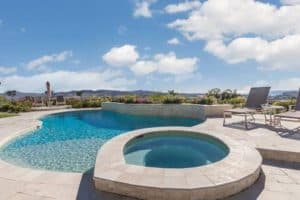 To sum this all up, at Pool Heaven, we use chlorine tablets in the summer and then switch to liquid chlorine as soon as possible after summer weather permitting to prevent over-conditioning our swimming pools. This makes for more perfect pool water chemistry for a longer lifespan for our customer’s swimming pools which is our objective. So, next time you notice that there are no chlorine tabs in your swimming pool and your pool water is sparkling and blue, appreciate that your pool service is probably using liquid chlorine instead of tablet chlorine to promote longer life for your pool water. Perfect pool water chemistry will extend the life of your pool and is a major part of your Pool Heaven!
To sum this all up, at Pool Heaven, we use chlorine tablets in the summer and then switch to liquid chlorine as soon as possible after summer weather permitting to prevent over-conditioning our swimming pools. This makes for more perfect pool water chemistry for a longer lifespan for our customer’s swimming pools which is our objective. So, next time you notice that there are no chlorine tabs in your swimming pool and your pool water is sparkling and blue, appreciate that your pool service is probably using liquid chlorine instead of tablet chlorine to promote longer life for your pool water. Perfect pool water chemistry will extend the life of your pool and is a major part of your Pool Heaven!
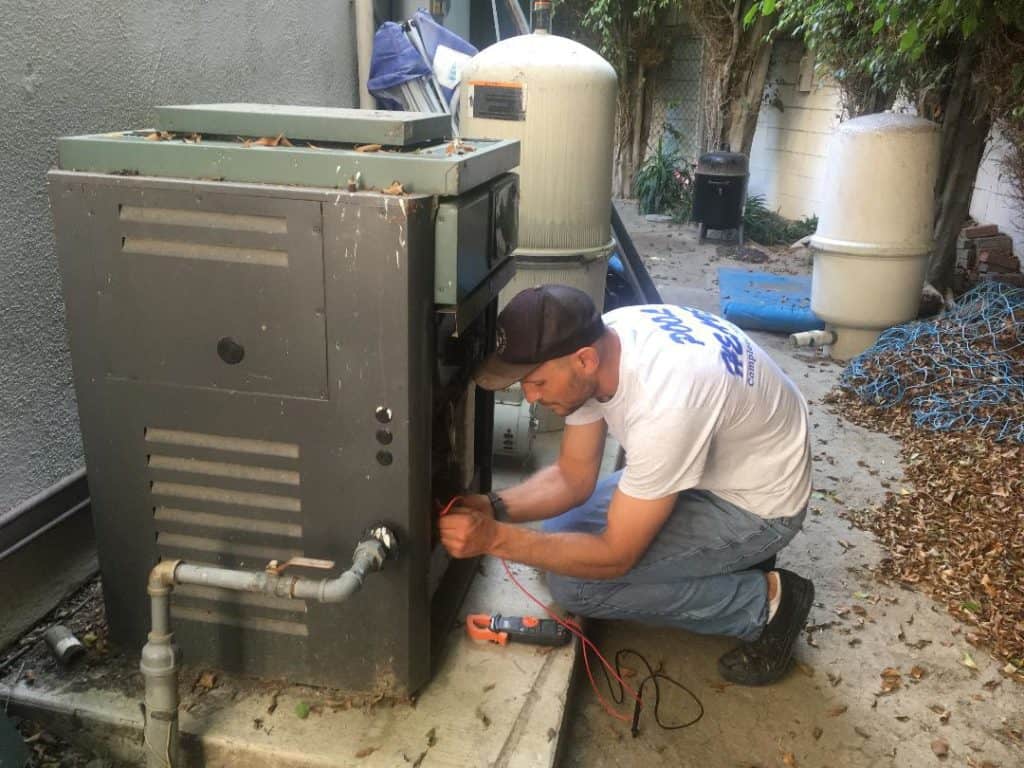
If you need help with any pool or spa projects in Orange County, Ca., provide us your information and we will respond with more info. and a free estimate or if we don’t provide the service, we will have the pool professional we use and trust contact you .
Check out one of these informative articles below or type in any swimming pool or spa related topic and click search.
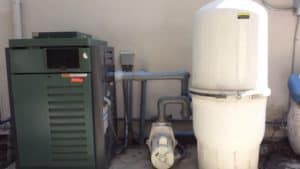
10 Best Pool Equipment Maintenance Tips in Orange County, Ca.
Here are the 10 best pool equipment maintenance tips that can help sustain the life of your pool equipment and provide sparkling, clear pool water:
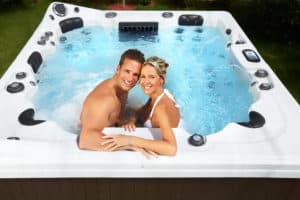
Safe Spa Water in Irvine, Ca.!
One of the most common misconceptions in pool and spa ownership is that spas are easy to take care of, because they are so much
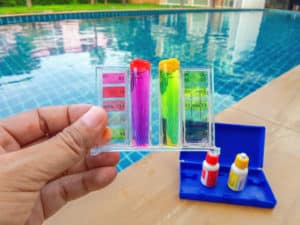
Dead Animal in Pool in Fountain Valley
It can be shocking to see a dead animal in pool issue. Let us start by informing you that this is quite common and most
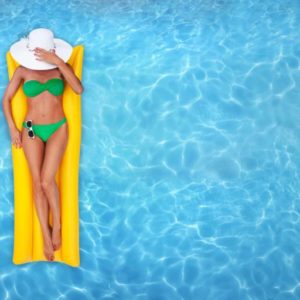
What is the role of Chlorine in pool water?
Water Chemistry Share Chlorine is a crucial element in maintaining properly balanced pool water. It is used as a disinfectant to kill harmful bacteria, viruses,

